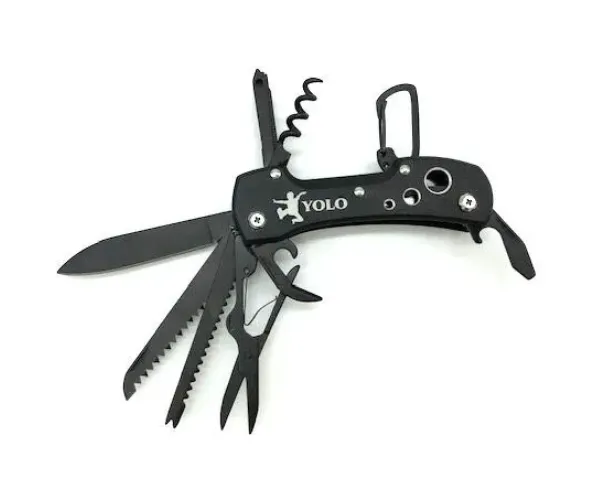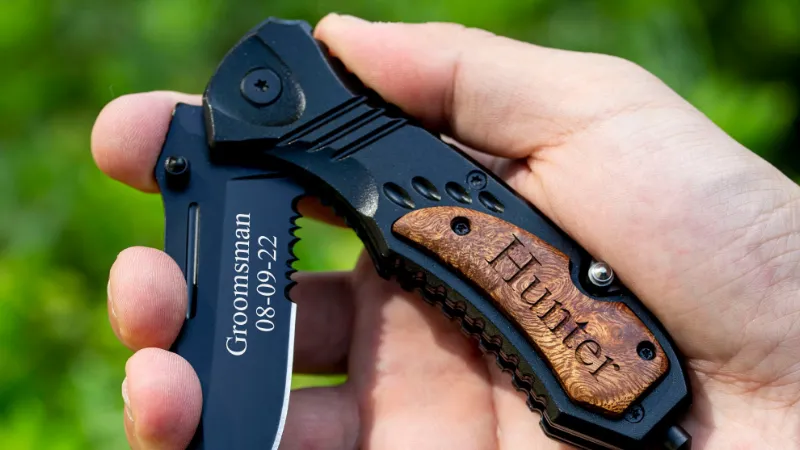For making cuts while traveling, pocket knives are a practical tool. Here are the tops tips on how to close a pocket knife.
Knives come in a variety of designs and have a number of locking systems to keep the blades secure.
Any type of knife you use can be safely closed and put back in your pocket, where it belongs.
Table of Contents
How to Close a Pocket Knife?
Here are the easy steps on how to close a pocket knife:
Slip Joint
One of the more common and casual types of pocket knives are those with a slip joint lock. These non-locking folding blades are excellent for routine daily tasks even though they are not designed for heavy-duty work. This style of pocket knife is very simple to shut.
Simply press down on the blade’s back to close it. Basically, closing the knife requires applying any downward force to the back of the blade.
Frame Lock
A frame lock is a particular kind of pocket knife that has a locking mechanism on the outside that keeps the knife open. The blade automatically locks when it is fully extended. Normally, the locking device is found behind the blade.
Use your thumb to move the locking portion of the frame out of the way of the blade to close this particular type of knife. Once the locking mechanism is out of the way, you can simply press down on the blade’s back to move it to the closed position.

Liner Lock
Similar to a frame lock, this kind of pocket knife. The liner lock has a unique inner mechanism that holds the knife blade open, which is the primary distinction between it and a frame lock.
A liner lock can be closed in a manner similar to how a frame lock is closed. But rather than removing the frame lock, you should search for the inner liner lock, which is typically located at the base of the handle. This area of the liner will have a tab that you can pull apart with your thumb. You can then push the blade into the closed position by releasing it as a result.
Lockback
The handle of this particular pocket knife has a metal spine that secures the blade in place.
Find the finger cut along the knife’s spine to close a lockback knife. To disengage the locking mechanism, apply pressure to this exposed portion of the spine. By doing this, you’ll be able to easily close the knife and release the spine.
Button Lock
The button lock is a novelty locking system that many people find appealing and flashy. It is frequently found on stiletto style knives or other spring-loaded folders. Let’s quickly review the precise actions you must perform to quickly and safely close a button lock knife.
- The knife should be held in your dominant hand with the handle’s button release facing up and the blade pointing away from you.
- Press the button release on the handle firmly down using your thumb that is dominant.
- Use your other hand to fold the blade toward its closed position while maintaining pressure on the button with your thumb.
- Release the button after closing the blade approximately 1/4 of the way, then keep going until it clicks into the handle cavity.
Because of how quickly and easily the blade can be deployed, button locks can be great, but there are some safety issues you should be aware of. As a result, a single button press could cause the blade to be deployed unexpectedly, either inside your pocket or elsewhere.
The button lock is a popular blade locking system, but it has some drawbacks. It is typically found on various switchblades and quick deployment knives.
A spring that swiftly flings open the knife blade is released when you press the blade release button on a button lock knife. Button lock knives can open slowly or quickly, depending on how powerful the spring is.
Because of their quick release, button lock knives are often prohibited or illegal, which raises concerns about their safety and usefulness. Close a button lock switchblade or pocket knife with extra care and safety.
Bar Lock
Due to their slick and quick opening and closing, bar lock knives are very common on everyday carry knives. The specific steps you must follow to safely close an axis lock knife are covered in the section below.
- The knife should be held in your dominant hand with the blade outward.
- Pull the locking bar (which is on the handle just above the blade’s base) back using your thumb that is dominant.
- With your other hand, start closing the knife blade while keeping the locking bar held back with your thumb.
- Release the locking bar when the blade is about 1/4 of the way closed and continue closing it until it clicks into place inside the handle cavity.
The bar lock is a relatively easy-to-use yet reliable design that is typically found on more expensive or mid-range pocket knives. While the bar lock is the general name for this type of knife lock, Benchmade has their own patented version (which is the original) called Benchmade Axis Lock.
A small bar that fits inside a slot in the handle of the knife is how the bar lock operates. The spring-loaded bar slides easily into a groove in the back of the blade. The blade is released and given free rein to swing when you pull the bar back. After letting go of the bar, the spring pulls it into the notch in the back of the blade to lock the knife open or closed.
A bar lock knife typically has a release bar that can be accessed from either side of the handle, making it extremely ambidextrous and providing you with a little extra functionality if you need it.
Overall, the bar lock, also known as the Benchmade Axis Lock, is a strong locking system that is quick and simple to close once you understand how it operates.
Compression Lock
Compression lock knives and liner lock knives are remarkably similar, but there are some important differences in how they work and secure the blade. Let’s examine the operation of compression lock knives and discuss how to close them correctly and securely.
- With the handle cavity (where the blade folds into) facing upward and away from you, hold the knife in your dominant hand.
- Push the liner locking mechanism to the side of the handle cavity by reaching across the knife’s handle with your dominant thumb.
- Make a slow start at closing the blade with your other hand.
- Remove your thumb from the liner locking piece once the blade is about 1/4 of the way closed, then finish closing the knife until it locks into place inside the handle cavity.
A compression lock knife is closed in an exact replica of how a liner or frame locking knife is closed. Compression locking systems function similarly to those mentioned earlier in terms of how you close and interact with them, but the internal workings of the knife are completely different.
Compression locks are fundamentally distinct from comparable knives by a notch at the base of the blade and a stop pin inside the handle.
Without going into too much technical detail, a compression lock uses a liner inside the handle to hold the blade open or closed (it’s the metal piece you push to the side to close or open the knife). The liner tucks neatly into a notch at the base of the blade whether the knife is open or closed. The liner moves between a stop pin that is located inside the handle as well.
Closing a Pocket Knife: Overall Summary
The various methods for closing a pocket knife are as follows. No matter which model you own, we have attempted to cover the key types of pocket knives so that you are aware of exactly what to do.
Knowing how to close a pocket knife in the correct manner is essential from a safety point of view. Be sure to always use your dominant hand for the area that requires the most control. This lessens the possibility of slipping and hurting your hand in the process.
However, we also urge you to periodically make sure your pocket knife is still in perfect working order. Verify that the knife has a mechanism for storing the blade in the hilt when not in use. We don’t want the blade to automatically spring back up because mechanisms can wear out over time.
But if you adhere to the guidelines we’ve provided, as stated above, you shouldn’t encounter any issues. After that, you can carry your pocket knife without having to worry about getting hurt.




